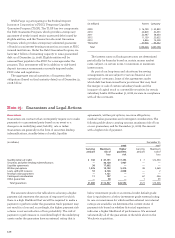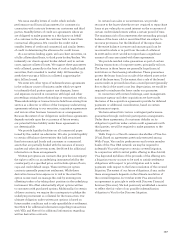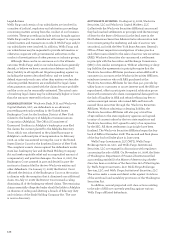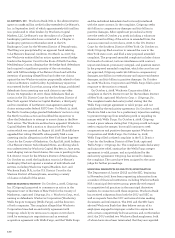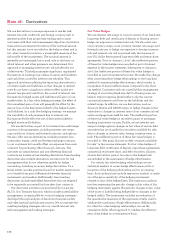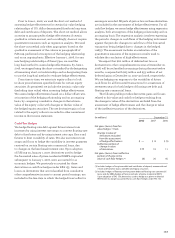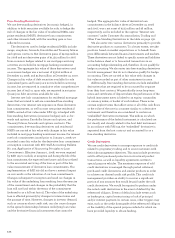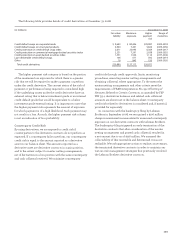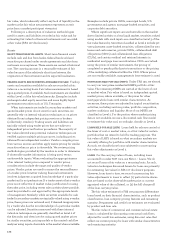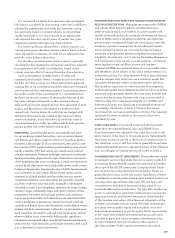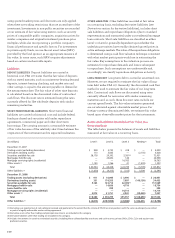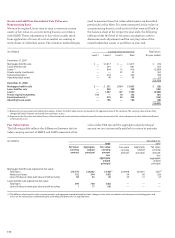Wells Fargo 2008 Annual Report Download - page 135
Download and view the complete annual report
Please find page 135 of the 2008 Wells Fargo annual report below. You can navigate through the pages in the report by either clicking on the pages listed below, or by using the keyword search tool below to find specific information within the annual report.
(in millions) December 31,
2008 2007 2006
Net gains (losses) from fair
value hedges (1) from:
Change in value of
derivatives excluded
from the assessment
of hedge effectiveness $— $8 $ (5)
Ineffective portion of
change in value
of derivatives 177 19 11
Net gains (losses) from ineffective
portion of change in the
value of cash flow hedges (2) (4) 26 45
(1) Includes hedges of long-term debt and certificates of deposit, commercial real
estate and franchise loans, and debt and equity securities.
(2) Includes hedges of floating-rate long-term debt and floating-rate commercial
loans and, for 2006, hedges of forecasted sales of prime residential MHFS.
Upon adoption of FAS 159, derivatives used to hedge our prime residential
MHFS were no longer accounted for as cash flow hedges under FAS 133.
Prior to June 1, 2006, we used the short-cut method of
assessing hedge effectiveness for certain fair value hedging
relationships of U.S. dollar denominated fixed-rate long-term
debt and certificates of deposits. The short-cut method allows
an entity to assume perfect hedge effectiveness if certain
qualitative criteria are met, and accordingly, does not require
quantitative measures such as regression analysis. We used
the short-cut method only when appropriate, based on the
qualitative assessment of the criteria in paragraph 68 of
FAS 133, performed at inception of the hedging relationship
and on an ongoing basis. Effective January 1, 2006, for any
new hedging relationships of these types, we used the
long-haul method to assess hedge effectiveness. By June 1,
2006, we stopped using the short-cut method by de-designating
all remaining short-cut relationships and re-designating them
to use the long-haul method to evaluate hedge effectiveness.
From time to time, we enter into equity collars to lock
in share prices between specified levels for certain equity
securities. As permitted, we include the intrinsic value only
(excluding time value) when assessing hedge effectiveness.
We assess hedge effectiveness based on a dollar-offset ratio,
at inception of the hedging relationship and on an ongoing
basis, by comparing cumulative changes in the intrinsic
value of the equity collar with changes in the fair value of
the hedged equity securities. The net derivative gain or loss
related to the equity collars is recorded in other noninterest
income in the income statement.
Cash Flow Hedges
We hedge floating-rate debt against future interest rate
increases by using interest rate swaps to convert floating-rate
debt to fixed rates and by using interest rate caps, floors and
futures to limit variability of rates. We also use interest rate
swaps and floors to hedge the variability in interest payments
received on certain floating-rate commercial loans, due
to changes in the benchmark interest rate. Upon adoption
of FAS 159 on January 1, 2007, derivatives used to hedge
the forecasted sales of prime residential MHFS originated
subsequent to January 1, 2007, were accounted for as
economic hedges. We previously accounted for these
derivatives as cash flow hedges under FAS 133. Gains and
losses on derivatives that are reclassified from cumulative
other comprehensive income to current period earnings, are
included in the line item in which the hedged item’s effect in
earnings is recorded. All parts of gain or loss on these derivatives
are included in the assessment of hedge effectiveness. For all
cash flow hedges, we assess hedge effectiveness using regression
analysis, both at inception of the hedging relationship and on
an ongoing basis. The regression analysis involves regressing
the periodic changes in cash flows of the hedging instrument
against the periodic changes in cash flows of the forecasted
transaction being hedged due to changes in the hedged
risk(s). The assessment includes an evaluation of the
quantitative measures of the regression results used to
validate the conclusion of high effectiveness.
We expect that $60 million of deferred net loss on
derivatives in other comprehensive income at December 31,
2008, will be reclassified as earnings during the next twelve
months, compared with $63 million and $53 million of net
deferred gains at December 31, 2007 and 2006, respectively.
We are hedging our exposure to the variability of future
cash flows for all forecasted transactions for a maximum of
seventeen years for both hedges of floating-rate debt and
floating-rate commercial loans.
The following table provides derivative gains and losses
related to fair value and cash flow hedges resulting from
the change in value of the derivatives excluded from the
assessment of hedge effectiveness and the change in value
of the ineffective portion of the derivatives.





